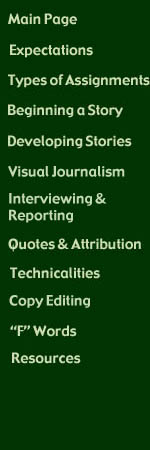

Beginning a Story
(printable version here)
The lede, also spelled lead, is the beginning to writing any story. A lede gives the reader the broadest sense of what your story will cover.
Finding an Angle
In the lede you choose the angle of the story. Stories covering the same thing can differ depending on the angle the writer chooses. For example, a story following the release of a new iPhone could have numerous angles. How is this product better than its predecessor? What do users of the new phone have to say about it (frustrated, pleased, etc.)? Are experts predicting it will change the cell phone market? If so, how? Or, one can broadly choose to incorporate all of those angles.
Writers should start with an interesting angle as well as emphasize the news. Avoid misleading readers, and stating the obvious. If a story covers a speech for example, the worst possible lead could begin with, "[speaker] made a speech Friday..." Instead, using more descriptive language and verbs the lede could begin, "Protestors reacted to a speech made on Friday by [speaker]..." or, if absolutely nothing interesting happened - highlight what the speech presented and how it relates to readers.
Crafting the Lede
Ledes are a crucial but tricky part to any story. The journalism textbook Reporting for the Media says ledes should attempt to answer the following five questions:
1. What is the most important information? What is the story's central point?
2. What was said or done about the topic? What happened or what action was taken?
3. What are the most recent developments? What happened today or yesterday?
4. Which facts are most likely to affect or interest readers?
5. Which facts are most unusual?
It also says ledes must answer WHO, HOW, WHERE, WHY, WHEN, and WHAT in stories.
Ledes must be concise and a writer should aim for about 30 words. So how does one implement all those elements in lede in such a brief word count? Writers pack ledes with information, and often exceed their word count goals.
Take for example, this story published tonight on NPR:
British voters will cast ballots Thursday in what political analysts are calling the most exciting U.K. election in 20 years and one that is likely to change the balance of parliamentary power.
For 32 words, you get who (British voters), how (casting ballots), where, when (Thursday), what, and why. The lede has also highlighted what will make the story noteworthy: "in what political analysts are calling the most exciting U.K. election in 20 years..." This is likely to pull in the reader with its engagement.
Ledes are always written in an active voice, unless the news or angle require otherwise. A handy tip for remembering this voice, writers should ask themselves WHO DID WHAT? (In a reporting sense, imagine you are telling someone 'who did what.')
Example: Terrorists shot and killed the Vice President last night in Afghanistan, following years of peace and violence in the region.
Example: Al-Queda, a terrorist organization thought to have been annihilated years ago, claimed responsibility for the murder of Vice President Gooseberry.
Remember, ledes should underscore that the news is new information to the readers, and something worthy of their thought after they've shut the laptop or left the paper. PRACTICE is the key to writing effective ledes. It often requires cautious and multiple revisions.
Other Disciplines | Writer's Web
| Writing Center | Make
an Appointment | Library |
Department of Journalism
Copyright 2010